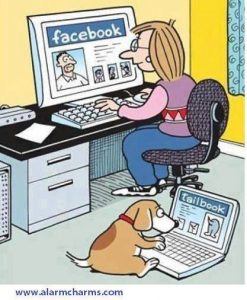Originally published: May 2, 2016

People are used to reading the body language of other Peoples as part of their interaction with one another. They often do it without even thinking. Some people assume that dogs are just animals and so are simplistic. But they are not. They too use a lot of body language: the shape of their eyes; position of their mouth, ears, and head; their stance; even a dog’s tail speaks of how they are feeling and what they are thinking.
 Different breeds of dogs have different natural positions for their tails, so allowances have to be made for breeds. For instance, breeds like Malamute, Husky, American Eskimo, and Chow all hold their tails curled up over their backs. Determining if their tail is higher than normal, lower than normal or about average is different than for most dogs who will hold their tails angled up from the spine, in line with the spine or lower, maybe even tucked under their butt, to indicate levels of anxiety.
Different breeds of dogs have different natural positions for their tails, so allowances have to be made for breeds. For instance, breeds like Malamute, Husky, American Eskimo, and Chow all hold their tails curled up over their backs. Determining if their tail is higher than normal, lower than normal or about average is different than for most dogs who will hold their tails angled up from the spine, in line with the spine or lower, maybe even tucked under their butt, to indicate levels of anxiety.
Keeping that in mind, here are some broad generalizations about how dogs use their tail to express themselves.
Context of a Dog’s Tail
First, be aware that what a dog’s tail is doing has to be considered in context with the rest of the body. If the dog has its teeth bared, ears back, and eyes slitted down, but the tail is wagging that does NOT mean the dog is happy to see you! Although he might be thinking that the chunk he’s going to take out of your leg will taste good (just kidding).
Height
One big indicator is the height at which the dog holds her tail. There are four major positions: up, neutral, down, and tucked. Keeping in mind what we said earlier about breeds, the abilities of their tail, and the relative positions for their breed (the DOWN position on a Samoyed looks much like the UP position of a Coon Hound), the higher the tail is held, the higher the level of excitement. Note that I said “excitement”, not “happiness”. It can mean extreme happiness, but it can also mean a high level of anxiety. You need to watch closely and take into account the other body language and the social situation.
If your dog’s tail is held high with the butt up and their forelegs on the ground, this is called a “play bow” and the dog is inviting another (or you) to engage in play. If the other dog feels similarly, good times will probably ensue. If the other dog is defensive, you should intervene, calm your dog and allow them to get acquainted first.
A high tail can mean your dog is really glad to see you again, or your dog has seen something he considers prey and wants to pursue.
When Cochise senses an unknown threat his tail stands straight up like a flagpole and the tip twitches rapidly while he peers intently and yips his concern.
A high tail means a high level of stimulation. This can be happy or unhappy.
Neutral
For most breeds a neutral tail is more or less straight out from the run of their spine. Fairly relaxed.
This means, “Condition Normal”, they’re not excited about anything. Again, consider the breed and their normal tail positioning. Neutral for a Husky will still be above their spine, for a Greyhound it will look droopy compared to most breeds. You have to get to know your dog and learn what is normal for their breed.
Low
A tail held low means the dog is nervous. She is unsure of what is happening and is assessing the situation. If she determines a threat, she could lash out in defensiveness. Use caution here. If there is no threat, calm her, reassure her that whatever is happening (maybe she’s meeting a friend of yours for the first time) is okay and there is no need to be “on alert”.
Tucked
A tucked tail means your dog is fearful or very nervous. Fear can quickly ignite into an attack or it may morph into submission. Submission is indicated by the dog rolling onto his side or back and presenting his belly. Essentially he’s saying, “Here are my soft underparts, kill me if you want, but I am no threat to you.”
A dog who crouches, tail tucked and head low, is scared but taking a defensive stance; violence is imminent. Defuse it quickly.
Wag Speed
When combined with the dog’s tail height, the speed and distance of the wag tells you much about what the dog is feeling.
Fast Wag or Twitching
The faster the tail is moving, the more excited the dog is. A high tail, moving quickly but a short distance indicates unfriendly intentions. It’s a warning. Take action to defuse the situation: move the dog away from whatever caused the anxiety and calm her.
A rapid wag at neutral height, especially with broad sweeping strokes, shows happiness. This should be accompanied by a relaxed stance, forward facing ears, round, happy eyes and an open, smiling mouth. But, if the body is tense, the ears pulled back and/or the mouth clamped shut, be wary! This dog is unsure of what it happening and could go either way.
A short, rapid wag (more like a twitching) at a low level or tucked usually means the dog is nervous. If his head is low, but the eyes are open wide and avoiding eye contact with whoever is approaching, he is being submissive and asking for acceptance.
Slow Wag
A slow, steady wag at the neutral position indicates a content, happy dog. This often includes holding the tail higher or lower than normal, as long as the wag is slow and steady.
No Wag
If a dog is holding her tail still and stiff, at any height this is a sign that she’s at alert and trying to assess the situation. If the tail is held high and stiff, it is generally a warning that she is highly anxious and violence could break out.
Neutral and still is a “yellow alert”: she is being wary and investigating. She’s not violent at the moment, but if a threat is determined, “red alert” may be initiated.
A highly fearful dog will have her tail tucked firmly and stiffly under her belly. She may even wet herself if approached. She is pleading to be left alone. To people, this may look heart-breaking and flood you with pity for the poor dog. But approach cautiously because if you reach for her, she may well turn to terrified-defensive mode and bite.
Wag to the Left, Wag to the Right
On many dogs, whether they are wagging predominantly to the left or to the right is difficult for us to tell because rarely will dogs be so clear and to wag from mid-line to one side. It may well be that the sweep is just a little shorter on one side than it is the other. Dogs are more talented in spotting these fine nuances than we are.
Basically, a wag that is predominantly to the dog’s right indicates a happy, calm, accepting mood. A wag that is predominantly to the left indicates anxiousness and is a warning.
What’s in a Wag?
By putting all these clues together – and taking into account some other general body language – you can create a pretty good picture of what your dog is feeling. When using these clues to assess an unfamiliar dog, use caution: you don’t know what is normal for that dog and you might misread a clue.
Think of a dog’s tail wag as sign language. Learn to read the signs and he’ll keep you updated on what is going on at the other end of his body. Learning to read your dog will make you more effective in training and in handling your dog.
| If you enjoy our updates, Doggy Tales, and educational articles consider subscribing for notices when new pieces are posted. It’s painless and you can unsubscribe any time you want. Your e-mail address is used ONLY to deliver these notices. | [email-subscribers namefield=”YES” desc=”” group=”Public”] |



